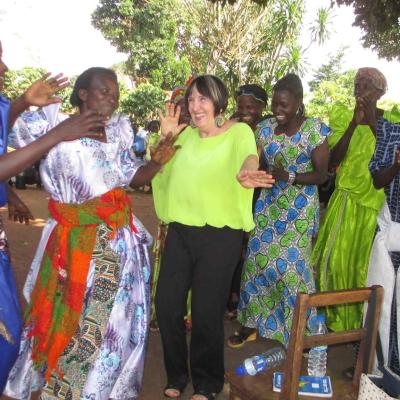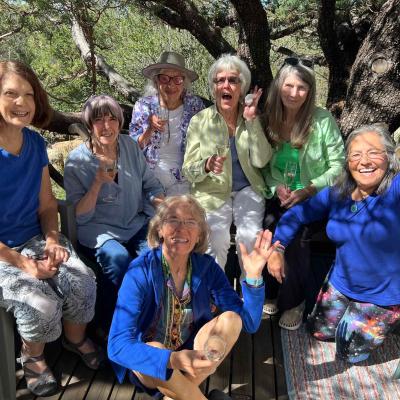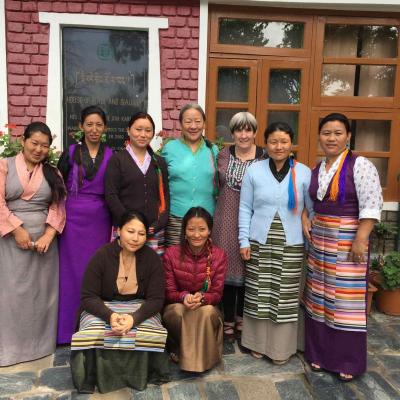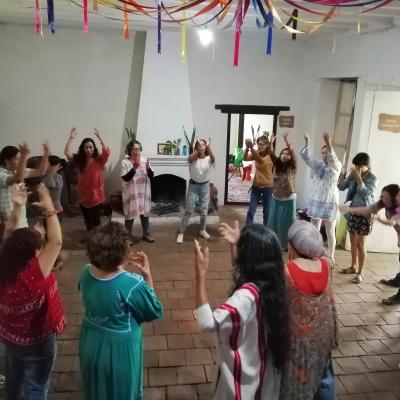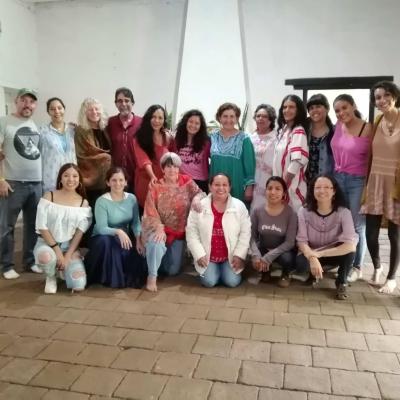On the Alchemy of Psychospiritual Transformation. (Spring 2006). Voices: The Art and Science of Psychotherapy, Vol. 42, Number 1, 59-67
On the Alchemy of Psychospiritual Transformation
© 2006 Sharon G. Mijares
The 13th century Sufi poet Jelaluddin Rumi presented a psychospiritual perspective that challenges our modern ideas about, and diagnoses of, depression, anxiety, anger and so forth. In a poem, translated by Coleman Barks in 1995, titled The Guest House, Rumi (p. 109) tells us,
This human being is a guest house
Every morning a new arrival.
A joy, depression, a meanness,
some momentary awareness comes
as an unexpected visitor.
Welcome and entertain them all!
Even if they're a crowd of sorrows,
who violently sweep your house
empty of its furniture,
still, treat each guest honorably.
He may be clearing you out
for some new delight.
The dark thought, the shame, the malice,
meet them all at the door laughing,
and invite them in.
Be grateful for whoever comes.
Because each has been sent
As a guide from beyond
This deeper, somewhat perplexing perspective certainly differs from the ads telling our clients that depression, anxiety and so forth are indications that something is wrong with them, and, in particular, their bodies (i.e., a chemical imbalance). Instead, it suggests that each inner expression and manifestation has something to teach us—when and if we learn how to listen.
A “house” in a dream is usually interpreted as representing one’s consciousness. Various rooms within the house can indicate differing feelings, memories, unrealized potentials, and even ego states. Rumi’s poem presents images of various sub-personalities or energetic expressions knocking on the door, perhaps to wake us up to a larger field of consciousness. This suggests an openness to explore consciousness at much deeper levels, for archetypal forces may arrive as guests—initiating an alchemical transformation.
Our lives present us with opportunities to discover our human potential and to achieve wholeness. Our spiritual prophets and psychological theorists (in particular, Carl Jung, Roberto Assagioli, Carl Rogers, Abraham Maslow, and Ken Wilbur) have all pointed out that life is a journey of Self Realization. But do we remember this when clients describe their symptoms? Or do we succumb to the downside of their archetypal stories of self-limitation and defeat? A guest may be bringing something to the client, but the message is yet to be understood--the client has not yet learned to listen to the deeper longings whispering in the shadows of his soul, or has not yet had a glimpse of the real Self.
My own individuation experience and background in Sufi mysticism 1 has had a profound influence upon my psychospiritual psychotherapy perspective and practice. I know, from personal experience, that dark forces are oftentimes misunderstood, for my own life has been one of transformation from self-destructive despair to various stages of spiritual realization. The first point of transformation occurred as Freudian theory (a psychoanalytical experience of regression) and Angelic presence met at the same time.
I lost connection with my inner self at a very young age. My sense of well being had been replaced by a drive of self-destructive behaviors. This path eventually led to suicidal behaviors in my early 20s. I experienced an ongoing conflict of wanting to be a “good person” and then punishing myself for being a “bad person.” Finally, after years of pain and a week-long struggle with an internal voice urging me towards self-destruction, I signed myself into a mental hospital. Several months later I began a vocational rehabilitation program, taking the bus to a nearby Cosmetology school. Thus began the first really pleasant period in my younger years (by then I was around 24 years old). It provided a safer place to begin the journey of rediscovering my self. But it began with a dream of danger, hiding and destruction.
The dream image and its emotional strength deeply disturbed me. It preoccupied me and drew me in. One association automatically led to another. I experienced a spontaneous hypnotic regression to a time when I was four years old. My mother had asked me to watch my six-month old baby brother for a moment. Upon her return she found me holding him up by his neck. Apparently I claimed he was falling and I was simply trying to hold him up (and the memory faded into my unconscious). For years, I had been told this choking event had caused his epilepsy. As the returned memory manifested, I heard this unbelievably (beyond human) compassionate, feminine, voice saying, “Forgive yourself, for you were only a child.” In this cathartic experience, I discovered that I had deliberately choked this “intruder,” who had taken away any hopes for love, and blocked out the memory in fear and self-judgment. It was a blatant example of Adler’s theory of sibling rivalry, exacerbated by an unloving and violent mother. The experience of divine compassion freed me as the memory surfaced. My life totally changed after about three days of abbreactive grief for the 21 years I’d spent in rather serious self-destructive behaviors. Most importantly, the previously destructive voice within had led me to the choices that would eventually initiate that transformative experience.
Clients with childhood traumata often describe an inner voice, driving them toward self-condemnation and self-destructive behaviors. It is difficult for both client and therapist to admit that this voice may actually be, albeit in a warped manner, making attempts to say “I don’t want to live this life (as I’ve been leading it), for there is another way.” It is a dangerous and precarious time, for this shadow force could lead to self-destruction or to self-revelation. I was blessed, for the darkly motivating force actually led me to decisions allowing me to truly begin living my life.
I began studying the world’s religious traditions. Prefaces and Forwards in books on Zen and Tibetan Buddhism were often written by Carl Jung. This led to reading his writings directly (with an open dictionary for assistance in that I had not yet completed my high school education). I immersed myself in both psychological and spiritual study.
Decades later, as a psychologist with a psychospiritually oriented practice, I began to gather the psychologists who would contribute to my first edited book (2003), Modern Psychology and Ancient Wisdom: Psychological Healing Practices from the World’s Religious Traditions. I then realized, as though for the first time, that my profession had begun in that regressive, and yet expanding, experience in the bathroom of a Beauty School bordering East L.A. My book was making a statement that limited psychotherapies and flat-lining drugs would do little, if anything, to deepen one’s life—for they ignored and even stifled the emergence of the greater Self. This was followed by a second book in 2005, The Psychospiritual Clinician’s Handbook, which discussed the possibility that a psychospiritual response to stress, and even abuse, “can actually open doors to transformation when treated within an integrative, psychospiritual paradigm” (p. 75)
Is there really a dividing line between psychotherapy and spiritual development? Perhaps they are simply different manifestations of the same thing—for both lead to human development. Psychotherapy, at its best, can help the client to move through the blocks on the way to becoming a complete human being. I suspect that this is true whether the psychotherapist recognizes it or not—for eventually the real nature and purpose of life will push its way into human attentiveness.
Like the seed pushing through the ground toward sunlight, the greater Self moves towards spiritual realization. Sooner or later it will emerge beyond any introjected influences established by familial, social and religious conformity. This awakening can present itself in many forms.
Indigenous peoples (in particular, those with shamanic traditions) often recognize that strong emotional crises can lead to creative life changes and expanded states of consciousness. The late mythologist, Joseph Campbell, recognized that an archetypal myth, the hero’s journey, appeared in every culture’s mythologies. Campbell believed that this heroic journey of individuation presented itself in four phases. The first stage represented a call—a recognition there is something more in life. But all great calls seem to bring obstacles with them, and so the second stage is that of facing obstacles. For example, can one listen to and follow the voice within (representing a heart-felt longing for a particular career, love or unity with the divine)? The person has to move beyond fear and other self-limiting emotions, thoughts and introjected influences, even though the outcome may be unknown. This stage has also been known as the dark night of the soul—in that the positive feelings associated with the call disappear as one enters into the darkness leading to a rebirth in one’s life. Like the caterpillar within the cocoon, the adventurer enters a process of creative transformation and self discovery (this emergence represents the 3rd stage). The fourth stage brings one back into the society. The individual has attained wisdom or some healing gift on his or her unique path of self realization to be shared with others.
We face heroic journeys as we deal with life’s challenges. In fact, most of our experiences have the potential to lead us to growth and development. This transformational model of human development offers a positive framing for dealing with the inevitable highs and lows of our own and our clients’ lives. This is why increasing numbers of clients are seeking psychotherapists who combine spiritual beliefs and related experiential processes with psychotherapy.
But one could make the case that all forms of psychotherapy, even the more accepted cognitive-behavioral models, are contributing to the journey towards wholeness. Who doesn’t have distorted cognitions? Or need the modeling of a preferred behavioral response? The limitations of these paradigms in themselves are two-fold. First, due in part to managed care and biomedically influenced models, they frame clients’ experiences into limiting diagnostic categories; and, second, they attempt to remove symptoms as opposed to learning to listen to them. They more often than not fail to recognize that life is an evolving process, moving toward wholeness. As Rumi advises,
Even if they're a crowd of sorrows,
who violently sweep your house
empty of its furniture,
still, treat each guest honorably.
He may be clearing you out
for some new delight.
Instead, clients are told that if they are depressed or experiencing anxiety, there is something biologically wrong with them. The significant loss is that the inner voice longing for something known or unknown is ignored in this paradigm.
One dictionary definition of the word “depressed” is being “pressed down” and “lowered in force.” For example, this could be one’s power, unexpressed feelings, the inner longing to love and be loved. Spiritually, there is a need to heal the fragmentation within ourselves that block the realization of human wholeness.
Psychologist Stephen Gilligan, a protégée of the late Milton Erickson, developed what is called Self Relations psychotherapy, based upon his training in Ericksonian hypnotherapy, Buddhism, Aikido, and other non-violent expressions. His website notes that Self Relations “emphasizes positive aspects of problems and symptoms. It sees such disturbances of the ‘normal order’ as evidence that ‘something is waking up in the life or a person or a community.” Gilligan had a profound influence on my own psychotherapy style, as it harmonizes with my understanding and application of Sufi practices. In my chapter, written for Stephen Gilligan and Dvorah Simons’ edited book, Walking in Two Worlds, released in 2004, I explained my understanding as follows:
The process of becoming fully human requires transformational and integrational experience. It means developing a compassionate attentiveness to somatic sensations, inner voices and feelings. In Sufism as I have learned and practiced it, no ego state or archetypal influence is taboo, for how can we talk about creating peace and honoring diversity in the outer world if elements of our inner world are criticized and rejected? (p. 181).
This belief is a primary bridge between my practice of Sufism and my work as a Self-Relations Psychotherapist. Self Relations is a psychotherapy focusing on the relationship of the cognitive self (in the head) and the feeling, archetypal self/ves in the body. It recognizes that the unconscious mind is a vast field, and that breaks within the field (for example, a split between the cognitive self and the somatic self/ves) need healing, in order to experience the greater unitive experience of spiritual realization.
This idea is not new. It is expressed in the 13th century Rumi’s poetry; it is found in teachings of Sufism and Kabbala (Jewish mysticism). It was also recognized by the late Roberto Assagioli, who founded a psychotherapy known as Psychosynthesis. This form of psychotherapy focuses on the various subpersonalities that are a normal and natural process occurring in human consciousness. In the process of developing his theory and process of integration, Assagioli studied and was influenced by Sufi and Kabbala beliefs. In the introduction to The Psychospiritual Clinician’s Handbook, I noted that Assagioli
had originally embraced the initial wave of psychoanalytic thought, but soon realized it failed to include the broader fields and potentialities within human development. Like Freud, Assagioli studied the mystical writings of Jewish Kabbalistic teachers. Whereas Freud had reinterpreted these mystical writings in secular terms, Assagioli accentuated the spiritual teachings and incorporated them into a process of psychospiritual development. Assagioli studied the writings of Gershom Scholem, (a modern Jewish mystic), developed a friendship with Martin Buber and was the Italian translator for the Sufi teacher, Hazrat Inayat Khan. (p. 10).
Both Assagioli and Jung studied the records of these ancient Sufi and Jewish mystic—alchemists. They recognized the alchemical ideal concerning the transformation of base metals into gold was an allegory regarding the conversion of the limited human personality into its higher Self. Alchemists drawings contained images of the balance of male and female, dark and light, child and animal selves. The integration of these archetypal influences was considered a major element on the path of individuation leading to human wholeness.
Psychospiritual psychotherapy recognizes that clients need healing from past experiences, but also acknowledges that there is a great potential for growth and development as we process the learning. For example, painful experiences can soften the heart as we learn compassion for our selves and others. Anger can evoke the fierceness of the warrior archetype needed for clarity of intention, expression of one’s truth, and protection of boundaries. Jung pointed out that the primary value of dealing with childhood trauma is to recover the natural spontaneity and creative power of the divine child, which are blocked in traumatic experience. This is positive psychotherapy. Although this sounds like a description of Jungian psychotherapy, it is not in that psychospiritually focused treatments include spiritual practices. In particularly, these include breath, entoning divine qualities (mantric practices) and meditative states.
Much can be learned from attentiveness to the breath. Training and freeing of the breath is the most important spiritual therapy. It is the force that provides life, and the breath may be restrained, held back, as a result of life’s myriad disappointments and traumatic experiences. Ancient Hindus, Egyptians and indigenous traditions recognized the inherent spiritual nature of the breath, and its ability to enhance consciousness.
Practitioners of the mystical traditions of Sufism and Kabbalism recognize that breath illuminates the various sub-personalities and archetypal forces moving behind the primary ego identity. This recognition melded well with both Jung and Assagioli’s experiences. Since my experience and training is derived from the Sufi tradition, I am glad to have this opportunity to share my own understanding of the importance of the breath in the path leading to greater and greater self realization. Let us examine some stanzas another Rumi poem, A Goat Kneels, translated by Coleman Barks in 1990. They provide powerful image of these differing archetypal energies moving through human consciousness, illuminated by the breath.
The inner being of a human being
Is a jungle. Sometimes wolves dominate,
Sometimes wild hogs. Be wary when you breathe!
At one moment gentle, generous qualities,
like Joseph’s [or Mary’s] pass from one nature to another.
The next moment vicious qualities move in hidden ways…
…At every moment a new species arises in the chest—
now a demon, now an angel, now a wild animal.
There are also those in this amazing jungle
Who can absorb you into their own surrender.
If you have to stalk and steal something,
steal from them.
The late Sufi Master Hazrat Inayat Khan explained that breath was “like a glowing electric wire” and that, “as the heat and light are not confined to that glow but are around it too, in the same way the radiance of this circle is breath, which goes on through the body, touches every part of the body…” He noted that the breath causes a different action and differing results in every direction it travels and that “if the breath does not [move] in one direction, then that particular activity of the body is stopped.” Inayat Khan also taught that once the spiritually refined breath has enabled a person to touch the depth of his or her own being, “then it becomes easy for him [or her] to become at one with all that exists on earth and in heaven.”
The psychospiritually focused client is being guided in greater awareness and responsibility for it. This entails learning how to integrate the various forces that were there all along, creating disturbances and symptoms because their presence, needs and contributions were being ignored. This is somewhat like a child misbehaving to get its parents’ attention and love. Another example is the person who has not acknowledged the desire to exercise more authority and receive related respect in her life; instead, she treats others with jealousy and disrespect. These psychological problems lead one to greater human development when one begins to see what the projections are saying. And this development clears the path for greater spiritual illumination. Conscious breathing practices enable greater clarity within, as they increase the flow of healing energies moving through mind and body.
Sufis also intone sacred phrases, called Wazif. These mantric sounds have an alchemical influence on both body and mind. Historically, Americans became more aware of Eastern mantric practices in the late sixties, when the Beatles and other rock stars were given “mantras” by their Yogis. The practice of Wazif, intoning the 99 Names (Attributes) of God, is called Jappa in the Yogic traditions. (The practice of chanting divine attributes is included in Buddhism, and in Middle Eastern traditions still practicing early forms of Christianity.) In Sufism, as in other depth traditions, God is not a human being in the sky, but rather the unifying essence from which all creation emerges. These mantric practices help one to realize this divine essence within. It is a way to actually embody the vibration of the word. For example, in Sufism names of God “are “Jamil (beauty), Qadr (power), Latif (subtle), Aziz (victory), Karim (generousity of spirit). Each is understood as a pure expression of consciousness. The intoning of Wazifas invokes specific attunements found in the essence of the phrase. For example, intoning the Wazifa “Ya Jamil” (beauty) can invoke the attribute of beauty and alchemically enhance one’s human potential.
The following client example was described in my chapter in Stephen Gilligan and Dvorah Simons’ edited book, Walking in Two Worlds. It is the story of a client who had come in requesting hypnotherapy to investigate suspected childhood abuse by a second grade school teacher. She wanted to see me because she had heard I followed a psychospiritual paradigm. In short, this young woman was having intense abbreactive experiences of trauma. She responded well to breathing and entoning processes. I suggested she intone two Wazifas, known as the Healer, Ya Shafee and the Remedy, Ya Kafee. They were taught in the office and given as daily homework. She began to experience coherent memories of the abuse in my office. I realized it was true that a school teacher had both abused and terrified her. She was suddenly overwhelmed with waves of terror. I spontaneously reached for her and took her hand. The energy of terror felt strong enough to take her from her body so the hand connection was very grounding. I reminded her that she was a thirty- six-year old mother of three children, and that this neglected child self, needed her adult’s love and its compassionate healing. We intoned the Wazifa Ya Raheem (the Compassionate One) and then gently breathed the sound into the belly. She also learned that her spiritual and psychic health required her to be present with her own inner development, something she often failed to tend to when caring for her family. The deeper connection to herself, her spirituality and its meaning in her life enabled her to quickly move through and integrate the trauma. She felt a deepened connection to her higher self.
Semitic and Sanskrit languages are based on the feeling embodied within the word as opposed to a conceptual understanding of it, which by its very nature separates mind and body. In short, mantric practices enable the vibration of the sound to come alive within the practitioner’s body. These practices of breath and intoning enable a permeability (this is not difficult to understand if one applies the findings of modern physics). This permeability deepens one’s meditative experience, for the practitioner begins to embody the peace and inner unity s/he has been seeking all along. Permeability enables one to also experience what Jung called the archetype of the Self, and the realization one is much more than the ego identity associated with our day to day lives.
Many years ago I was standing on a hillside in New Mexico, talking with my own Sufi teacher. I was actually apologizing for my imperfections, when suddenly the Higher Self, embodied compassion, was present. It was as though a breath had breathed into me, and dualism did not exist. And then, I was back to myself, left with the impression, the dualism and my ordinary egoic self. I’ve had this embodied experience a few times since, and it is always a good reminder of what most of our religious teachings have proclaimed—that we are much more than our ego identity, with all of its problems. I believe this experience was enabled as I had practiced listening to the voices speaking within the shadows of the body-mind.
What are our emotional states (envy, anger, despair, longing) attempting to achieve? Breath enables realization, and its fluid movement allows an openness to deepened states of awareness. Mantric practices can help fulfill the quest for healing and wholeness in a spiritually healthy manner, whereas meditation enables the discipline of the mind and facilitates Realization. Thus, Self Realization, the highpoint of the pyramid of Abraham Maslow’s hierarchy of needs, becomes a greater possibility.
This is what the combination of psychotherapy and spiritual guidance are moving us towards. In the past, these spiritual practices were solely the domain of recognized spiritual teachers. And they still are, for the average psychotherapist lacks the proper training to recognize and safely enable spiritual states, just as the average spiritual teacher lacks the in depth training and skill of a seasoned psychotherapist. But much of humanity is under considerable stress at this time and the need for real psychological and spiritual development is crucial. This is why increasing numbers of religious teachers are taking psychology courses, and numerous psychotherapists are utilizing their own spiritual training in psychotherapy. The primary ethical standard is that one should not apply what one has not experienced in his or her own training and life. I should mention that I am not speaking of theology and its more dogmatic teachings, but rather a true experiential opening to the psychospiritual possibilities of a healing, unitive experience. These are the ultimate goals of Jung’s theory of Individuation, Assagioli’s theory of Psychosynthesis and Maslow’s theory of Self Actualization. They are best realized in psychospiritual practice. Healing, spiritual processes leading us to become better human beings, concerned with the wellbeing of others, as well as our own, is what is needed in these strenuous times.
_____________________________________
1 Sufism is considered to be the mystical experience of unity with the divine. Some say Sufism began with the Prophet Muhammad, and dictionaries often describe it as an esoteric expression of Islam. Other groups believe it began in ancient Egypt (Hermetic teachings). Many Sufi traditions believe its emphasis on spiritual unity to be the core essence of every religious tradition. These groups focus more on universality, although they all use similar practices of entoning (mantric chanting) and breathing practices that evoke the sacred names (qualities) of cosmic expression.

